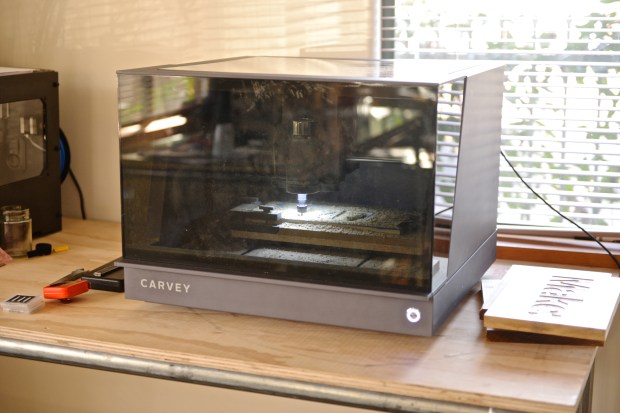

I’ve been eager to test out Carvey, Inventables’ new self-contained CNC router, since it launched on Kickstarter a few weeks ago. Inventables was also keen to see what Make: would do with this new 3D-carving machine (as they call it), so they sent us one of their prototypes to play with. And after a week with it, I’m being honest when I say I plan to do everything I can to not return it.
Carvey arrived the week of my son’s 6-month birthday, and I wanted to make a momento for the occasion — a wooden carving of his hospital certificate, done in a two-tone color scheme using a piece of ¾” wood I had painted blue.
I converted a scan of his certificate into an SVG vector file (using Adobe Illustrator) and imported it into Easel, Inventables’ free and incredibly easy to use CNC software, with which Carvey is designed to interface seamlessly. Set the depth for the carving, clamp the wood in place, tell the software what type of wood it is, what size bit you’re using, and click “carve” — it’s as simple as that, with the machine determining the necessary paths and speeds, spinning up, and creating your masterpiece. It’s advertised to be minutes to go from design to carving, and this integration is what really makes the Carvey experience so addictive.

The most striking part about Carvey is its fully enclosed, sleek black design (created by MNML, the team that designed the XBox 360). The sealed workspace is a rarity with CNC machines, and is built to keep the noise low enough to have a phone conversation while carving in the same room. I can attest that this is indeed the case, especially with the 1/16” bits. The enclosure also holds in the chips and sawdust. Set in our work offices, there was never a mess, and the loudest noise of the process came from the vacuum we used to clean the inside of the machine when a carving was finished.
Carvey has an 8×12-inch bed with a 2.75-inch Z-depth capability. It cuts material with a beefy 300 watt spindle. It automatically interfaces with Easel, and can also process Gcode from other software packages. Priced at $2000-$2400 on Kickstarter, the machine has a bigger platform at a lower price than the few other self-contained CNC machines that are available.
After my first carve, I made a few other pieces for home — including a fridge magnet of my son’s baby’s footprints, placing magnets into press-fit holes cut precisely on the back side of the carving. I made the Make: logo. And I have a carving going of Makey the Robot as I type this.
I’ve also learned a very interesting tip about Easel and imported SVGs. When starting to use the software, you’ll likely initially set the depth of the carved elements within Easel — and it can support multiple depths, allowing for some interesting multi-level creations. But it will also set the depth of a design element in an SVG file based on its shade of gray. Pure black will be cut at 100% depth, pure white won’t be cut at all. If you want an intricate design to be partly cut at 50% depth and partly at 25% depth, pre-determining this is as simple as setting each area’s color in Illustrator before saving the SVG file — up to 255 levels of depth can be set this way.
And with this, you can create contoured carvings on Carvey using Easel. It’s not officially a feature that the company is supporting (they’re working on a more official process that will be released soon, one that hopefully imports STL files into Easel), but it works and has been giving us a lot of exciting ideas about new projects to do with the machine before we return it — if we do return it, that is. Let us know if there’s something you’d like us to make on it and we’ll update with the results.
The Kickstarter for Carvey finishes this Thursday. For schools, design shops, or hobbyists like myself, it’s a no-brainer.
ADVERTISEMENT












